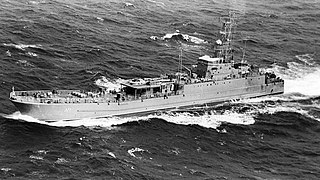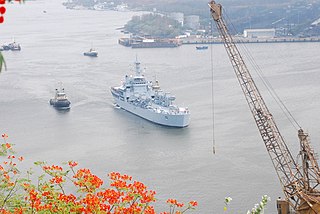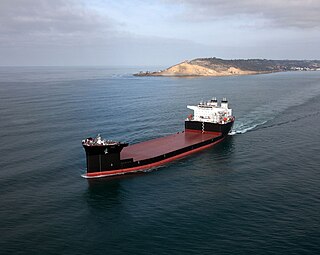
The San Antonio class is a class of amphibious transport docks, also called a "landing platform, dock" (LPD), used by the United States Navy. These warships replace the Austin-class LPDs, as well as the Newport-class tank landing ships, the Anchorage-class dock landing ships, and the Charleston-class amphibious cargo ships that have already been retired.

Landing craft are small and medium seagoing watercraft, such as boats and barges, used to convey a landing force from the sea to the shore during an amphibious assault. The term excludes landing ships, which are larger. Production of landing craft peaked during World War II, with a significant number of different designs produced in large quantities by the United Kingdom and United States.

The Indian Navy is the maritime branch of the Indian Armed Forces. The President of India is the Supreme Commander of the Indian Navy. The Chief of Naval Staff, a four-star admiral, commands the navy. As a blue-water navy, it operates significantly in the Persian Gulf Region, the Horn of Africa, the Strait of Malacca, and routinely conducts anti-piracy operations and partners with other navies in the region. It also conducts routine two to three month-long deployments in the South and East China seas as well as in the western Mediterranean sea simultaneously.

A Landing Ship, Tank (LST) is a ship first developed during World War II (1939–1945) to support amphibious operations by carrying tanks, vehicles, cargo, and landing troops directly onto a low-slope beach with no docks or piers. The shallow draft and bow doors and ramps enabled amphibious assaults on almost any beach.
The names of commissioned ships of the United States Navy all start with USS, for United States Ship. Non-commissioned, primarily civilian-crewed vessels of the U.S. Navy under the Military Sealift Command have names that begin with USNS, standing for United States Naval Ship. A letter-based hull classification symbol is used to designate a vessel's type. The names of ships are selected by the Secretary of the Navy. The names are those of states, cities, towns, important persons, important locations, famous battles, fish, and ideals. Usually, different types of ships have names originated from different types of sources.

A Landing Craft Utility (LCU) is a type of boat used by amphibious forces to transport equipment and troops to the shore. They are capable of transporting tracked or wheeled vehicles and troops from amphibious assault ships to beachheads or piers.

USS Frederick (LST-1184) was a Newport-class tank landing ship which replaced the traditional bow door-design tank landing ships (LSTs) of the United States Navy. The ship was named after the city of Frederick, Maryland and Frederick County, Maryland. The vessel entered service in 1970 with the United States Pacific Fleet and saw service during the Vietnam War, and the Persian Gulf War earning three battle stars. The ship was decommissioned in 2002 and put up for sale.

The Galicia class are two landing platform dock (LPD) ships in service with the Spanish Navy. Built by Navantia at Ferrol, their mission is to carry out amphibious warfare by transporting the bulk of the Infantería de Marina. These ships have both a large helicopter flight deck and a 885-square-metre (9,530 sq ft) well deck for large landing craft, as well as a 1,000-square-metre (11,000 sq ft) space for up to 33 main battle tanks.
The Force d'action navale is the 9,600-man and about 100-ship force of surface warships of the French Navy. As of August 2023, it is commanded by L’amiral Nicolas Vaujour.
A joint support ship (JSS) is a multi-role naval vessel capable of launching and supporting joint amphibious and airlift operations. It can also provide command and control, sealift and seabasing, underway replenishment, disaster relief and logistics capabilities for combined land and sea operations.

The America class is a ship class of landing helicopter assault (LHA) type amphibious assault ships for the United States Navy (USN). The class is designed to put ashore a Marine Expeditionary Unit using helicopters and MV-22B Osprey V/STOL transport aircraft, supported by AV-8B Harrier II or F-35 Lightning II V/STOL aircraft and various attack helicopters. The first of these warships was commissioned by the U.S. Navy in 2014 to replace USS Peleliu of the Tarawa class; as many as eleven will be built. The design of the America class is based on that of USS Makin Island, the last ship of the Wasp class, but the "Flight 0" ships of the America class will not have well decks, and have smaller sick bays to provide more space for aviation uses.

INS Jalashwa is an amphibious transport dock currently in service with the Indian Navy. Formerly USS Trenton, she, along with six Sikorsky SH-3 Sea King helicopters were procured from the United States by India for a total of US$90 million in 2005. She was commissioned on 22 June 2007. INS Jalashwa is the only Indian naval ship to be acquired from the United States. She is based in Visakhapatnam under the Eastern Naval Command.

The Polnocny -class ships are amphibious warfare vessels. They were designed in Poland, in cooperation with the Soviet Navy and were built in Poland between 1967 and 2002. They now serve in several different navies, and some have been converted to civilian use. The name comes from the Stocznia Północna shipyard at Gdańsk, where they were built. 107 were built by 1986. In 2002, one ship of a modernised design NS-722 was built in Gdynia for Yemen.

Shardul-class landing ships are large amphibious warfare vessels built at Garden Reach Shipbuilders and Engineers for the Indian Navy. They are an evolution of the Magar-class amphibious landing ships. Initially, the ship was classified as Landing Ship Tank (Large) or LST(L). The class has an indigenous content of over 90%. The ships also carry four landing craft vehicle personnel (LCVP) on board, which can be used for the landing of troops.

An amphibious warfare ship is an amphibious vehicle warship employed to land and support ground forces, such as marines, on enemy territory during an amphibious assault.

The United States Navy (USN) is the maritime service branch of the United States Armed Forces and one of the eight uniformed services of the United States. It is the world's most powerful navy with the largest displacement, at 4.5 million tons in 2021. It has the world's largest aircraft carrier fleet, with 11 in service, one undergoing trials, two new carriers under construction, and six other carriers planned as of 2024. With 336,978 personnel on active duty and 101,583 in the Ready Reserve, the U.S. Navy is the third largest of the United States military service branches in terms of personnel. It has 299 deployable combat vessels and about 4,012 operational aircraft as of July 18, 2023.

INS Magar was the lead ship of Magar-class amphibious warfare vessels of the Indian Navy. She was built by Garden Reach Shipbuilders and Engineers, Kolkata and was commissioned by Admiral R.H. Tahiliani, Chief of the Naval Staff on 15 July 1987. The ship has a length of 120 metres and a beam of 17.5 metres. The main weapon systems of the ship consist of CRN 91 Guns, chaff launcher (Kavach) and the WM-18A Rocket launcher. The ship also carries four landing craft vehicle personnel (LCVP) on board, which can be used for the landing of troops.

An Expeditionary Transfer Dock (ESD), formerly the Mobile Landing Platform (MLP), is designed to be a semi-submersible, flexible, modular platform providing the US Navy with the capability to perform large-scale logistics movements such as the transfer of vehicles and equipment from sea to shore. These ships significantly reduce the dependency on foreign ports and provide support in the absence of port availability. The class also houses a sub-class variant called the Expeditionary Mobile Base (ESB), formerly the Afloat Forward Staging Base (AFSB).
The procurement of Landing Platform Docks (LPD) by the Indian Navy, formerly known as the "Multi-Role Support Vessel Program" (MRSV) - is an initiative of the Indian Navy (IN) to procure a series of landing platform docks, specific vessels dedicated to amphibious warfare, as part of the service's strategy to augment its capabilities of amphibious warfare, disaster-response, humanitarian assistance and auxiliary duties.

















